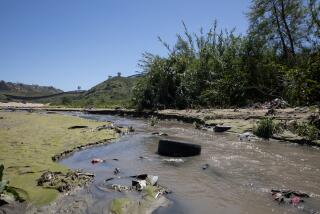Studies Conflict Over Radon Danger : Health: Local officials cite survey in urging testing. But EPA, state authorities find problem less pervasive.
Even as local health officials sought Thursday to mobilize public concern over radon, their state and federal counterparts were preparing to unveil a new study that shows California near the bottom of the nation in the prevalence of the odorless-but-lethal gas.
Officials with the Los Angeles County Health Department and the American Lung Assn., hoping to combat what they see as public apathy over an easily solvable problem, presented figures suggesting that radon is more widespread in this area than previously believed.
Their survey of existing data estimates that in 4.4%--or 75,000 homes--in the county, radon levels exceed U.S. health guidelines. It says 100 people a year may die from exposure to radon, a naturally occuring gas that is second only to cigarette smoking as a cause of lung cancer.
But the credibility of the new estimate was immediately challenged by specialists in the field because of the way it was carried out. A second survey, due for official release next week and said to be the most comprehensive to date in California, found the problem less pervasive.
The second study, conducted statewide by the U.S. Environmental Protection Agency and the state Department of Health Services through tests of 2,305 homes, estimates that 1% of households in Los Angeles County have potentially dangerous levels of radon. For the entire Southern California region, the figure is .6%.
The numbers are somewhat higher statewide, with the EPA and health department concluding that 3.5% of all homes may have excessive radon levels, or 2.4% when population differences are weighed in. Still, these estimates leave California third from the bottom in the severity of the radon levels among the 34 states tested.
By comparison, 71% of homes in Iowa and 61% in North Dakota recorded radon levels that should prompt action by the homeowner under federal health guidelines. Private contractors in the field say the cost of dealing with the problem, such as sealing wall cracks and improving ventilation, ranges from $500 to $1,500.
“Overall, we’ve found reasonably low levels in California,” said Dave Quinton, a state environmental health specialist who headed the state-EPA study.
Two years ago, a survey by The Times indicated that about 1.2% of households in Los Angeles, Orange, Riverside, San Bernardino and Ventura counties might exceed the EPA guidelines.
Philip M. Jacobs, a county health department epidemiology analyst who helped put together the review of existing test data, acknowledged that theirs was “a crude study . . . quick and dirty.” Critics pointed out that the review lacks consistency, mixing short- and long-term test results from a wide range of sources.
But Jacobs defended its general conclusions about the urgency of the radon situation, saying: “If a bomb is dropped on your head, do you really want to know how many kilotons it is? All you need to know is it’s going to explode.”
That was the bottom line for several state, county and American Lung Assn. officials who appeared at a press conference to urge all members of the public to spend as little as $14 to test their homes. Most adamant was Judy Steingeiser, a Northridge resident who said her husband, a non-smoker, died of lung cancer in 1985--because of what were later determined to be high radon levels in the home.
Release of the radon figures comes at a time of controversy over the EPA’s plans to publish a revised edition of its “Citizens Guide for Radon.”
Internal memos obtained by The Times indicate that the EPA is concerned by public apathy over the risk posed by radon. The EPA said that only 5% of U.S. homes have been tested for radon. As a result, an Aug. 16 draft of the new guide describes the risk in more threatening terms, describing radon as an “intruder” and a threat to children. But, this approach has been challenged by a number of scientists who believe the situation does not warrant such alarm.
More to Read
Sign up for Essential California
The most important California stories and recommendations in your inbox every morning.
You may occasionally receive promotional content from the Los Angeles Times.










